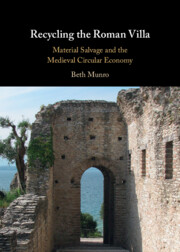Book contents
- Recycling the Roman Villa
- Recycling the Roman Villa
- Copyright page
- Dedication
- Contents
- Figures
- Tables
- Preface
- Acknowledgements
- One Introduction
- Two Valuable Villa Architecture
- Three Villa Decline and Material Salvage
- Four Materials Organization and Stockpiling for Recycling
- Five Material Reprocessing at Villas
- Six Economics of Villa Recycling
- Seven Post-Roman Ownership and Legacy of Villas in the Western Provinces
- Eight Conclusions
- Bibliography
- Index
Five - Material Reprocessing at Villas
Published online by Cambridge University Press: 08 November 2024
- Recycling the Roman Villa
- Recycling the Roman Villa
- Copyright page
- Dedication
- Contents
- Figures
- Tables
- Preface
- Acknowledgements
- One Introduction
- Two Valuable Villa Architecture
- Three Villa Decline and Material Salvage
- Four Materials Organization and Stockpiling for Recycling
- Five Material Reprocessing at Villas
- Six Economics of Villa Recycling
- Seven Post-Roman Ownership and Legacy of Villas in the Western Provinces
- Eight Conclusions
- Bibliography
- Index
Summary
Archaeological evidence of reprocessing installations (hearths, kilns, and other fire-powered operations) has been discovered at thirty-one villa case study sites, working lead, iron, bronze, gold, copper, glass, and converting limestone into quicklime. The spatial relationship between the installations and the rooms in the former villa indicates both that these workshops reprocessed salvaged architectural materials and utilized the footprint of the villa to undertake the operations.
- Type
- Chapter
- Information
- Recycling the Roman VillaMaterial Salvage and the Medieval Circular Economy, pp. 116 - 171Publisher: Cambridge University PressPrint publication year: 2024

